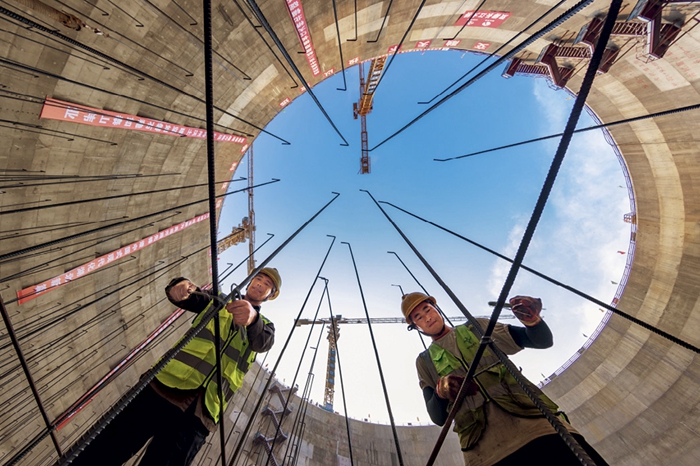Malindo Air OD634 flight passengers arrive at Qionghai Bo’ao international airport in Hainan, September 28, 2024.
For almost half a century, China has made the decisive choice of the structural reform of its economy while opening up to international flows of goods, capital and know-how. This methodical and visionary approach has transformed the conquest of external markets into a powerful engine of economic growth. Simultaneously, the reception of foreign investments has enabled the Chinese productive system to benefit from capital and technologies essential to its development. Since 2013, Xi Jinping resolutely has been continuing this movement by emphasizing “strategic autonomy”. This major orientation aims to place the internationalization of exchanges at the service of accelerated economic and technological development. Today, the results are palpable: China is the world’s leading industrial and commercial power, with an exceptional degree of opening for a continental saving.
Presented on March 5, 2025 by Li Qiang, Prime Minister of the Council of State Affairs, in the third session of the 14th National People’s Assembly, the government’s activity report is part of this continuity. When reading this report, it clearly appears that geopolitical turbulence will not prevent China from continuing the path it has chosen. For the Chinese Head of Government, it is imperative to continue to “expand the opening on the high -level outside” and to “stabilize foreign trade” as well as “foreign investments”. Whatever “external changes”, Beijing thus intends to persist “in the practice of opening”. Whether it is to develop the “regulatory framework” or “stabilize the development of foreign trade”, the Chinese government is determined to “intensify its policies in this area, while helping companies to maintain their volume of orders and to exploit the market”. Financial services, Crédit-Export insurance, cross-border cybercommerce, the cross-border fast shipping system or even the construction of warehouses abroad will be on the menu for government policy.

A buyer is negotiating with exhibitors in the clothing exhibition area of the 136th Canton Fair in Guangzhou (Guangdong), on November 1, 2024.
Another important aspect of this report is the insistence on “the integrated development of domestic and outdoor trade, by accelerating the resolution of the problems of certification and fluidity of the market”. The government will support innovation in order to “increase the competitiveness of traditional services with specific assets” while increasing “importing high quality services”. This is why “new growth centers will be born”, such as “green trade and digital trade”. The regions with the necessary conditions will develop a “new -type offshore trade”. China is the leading global investor in green energies, with 38 % of global investments in this sector in 2023. In addition, large international fairs, real exchange platforms between international operators, such as the Chinese import and export fair (Canton Fair) or the International Chinese Services trade fair, will be organized on a larger scale.
As part of the overall opening strategy, the Chinese authorities attach particular importance to the attraction of foreign investments. Developing international trade in a “win-win” spirit assumes that foreign companies can freely settle in China and develop their activities there. This strategic orientation, constant since the launch of the reform and the opening, will be amplified, as evidenced by the report presented by the Prime Minister. To materialize this ambition, “pilot experiences” will be carried out in order to expand the opening of services. Sectors such as the Internet, Culture, Telecommunications, Medical Cares or Education will be gradually open. To attract foreign investors, the Chinese government undertakes to “effectively guarantee companies with foreign capital the national treatment with regard to the acquisition of production factors, obtaining qualifications, establishing standards and public purchases”. This equality of treatment, long claimed by foreign investors, especially Western, constitutes a strong and positive signal.

End of the construction of an anchor foundation pit on the north shore of the Shuangliu bridge on the Changjiang river in Wuhan, April 9, 2024
The government therefore undertakes to “provide services to companies with foreign capital”, to accelerate “the development of emblematic projects” and to develop the concept “Investing in China”. To do this, the free trade pilot areas will have more autonomy, the Hainan free trade port will see its reinforced role, and policies in favor of economic and technical development areas will be continued. The objective is to promote “retraining and upmarket of integrated free zones” while creating “a first -rate business environment in accordance with Chinese law, market rules and international standards”. This approach aims to offer companies with foreign capital the optimal conditions to develop in China. These government announcements should end the speculations of certain Western circles which feared a possible abandonment, by China, of the international opening strategy, which has nevertheless made its success.
It is all the more true that the government’s activity report also insists on the continuation of the vast program initiated in 2013 as part of the initiative “The belt and the road”. China has established around this extraordinary system a global partnership which it intends to intensify by coordinating the construction of “emblematic major projects” and “small and beautiful projects” aimed at improving the well-being of the population. By developing international exchanges, this program will guarantee the stability and fluidity of the circulation of the Chine-Europe freight train, and will accelerate the construction of the new Western Terre-Mer communications system. It is a question, for the Chinese government, of directing investments abroad towards “a healthy, ordered and safe development”, in order to deepen “bilateral, multilateral and regional economic cooperation”.
Even if it intends to continue the development of its internal market by stimulating domestic consumption, China does not abandon the strategic objective of international opening, designed both as the engine of the development of the national economy and the co-development of partner countries. This is why the report reaffirms the need to expand “the free trade zones meeting high criteria and turned towards the whole world”, in particular within the framework of the China-Asean reports, the partnership agreement on the digital economy or the agreement of the global and progressive transpacific partnership. A major player in world exchanges, China intends to include its action in a “multilateral trade system focused on the World Trade Organization”. It is in his eyes the best way to obtain a real convergence of interests with its partners, in order to promote common development.
*Bruno Guigue is Professor Guest at the Normal University of Southern China.








